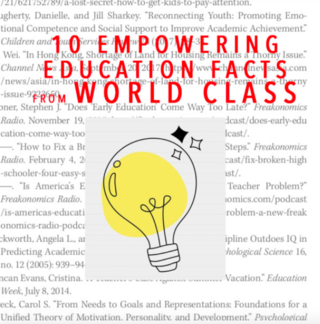Education
10 Empowering Education Facts from World Class
Research based tips and facts for raising and teaching children.
Posted December 2, 2019

1. According to researchers at Harvard’s Center on the Developing Child, in a child’s first few years “more than 1 million new neural connections form every second.”
2. A recent analysis of 22 high-quality studies from 1960 through 2016 found that children who attend early childhood education (ECE), defined as any schooling from birth to age 5, go on to have lower rates of special education placement (a difference of 8 percentage points), lower rates of grade repetition (7.9 percentage points difference), and higher high school graduation rates (9.4 percentage points difference).1
3. Researchers estimate a minimum rate of return of $3-$4 for every dollar spent on early childhood education.2 There are huge differences between educational spending per student when you compare state, local, and federal dollars; New York ($21,206 per year on the primary and secondary levels) versus Utah ($6,575) or North Carolina ($8,687), even after accounting for the cost of living differences.
4. The Hamilton Project found that kids living in poverty score worse on standardized tests, have lower graduation rates, and are far less likely to go to college, which means that their earning potential is significantly reduced. The difference is striking: less than 25 percent of fourth-graders who qualify for free or reduced lunch at school scored at a proficient level on the standardized math exam, whereas about 60 percent of other fourth-graders score at or above proficiency levels.
5. Research conducted by Angela Duckworth (University of Pennsylvania) and Martin Seligman (University of Pennsylvania) demonstrated that the best predictor of final grades was not IQ, but self-discipline. Using various measures to determine the 8th graders’ level of self-discipline, they checked in with students at the beginning and end of the school year. Duckworth and Seligman found that self-discipline scores had more than twice the impact as IQ on their final grades, attendance, hours spent on homework, time starting homework, and time watching television. Students should have more opportunities to learn self-control and discipline both at school and at home.
6. In Finland and Singapore, annual teacher attrition rates typically average as low as 3 percent to 4 percent.3 Japan’s annual teacher attrition rate is a low 1.35 percent.4 In the US, the national annual attrition rate is about 8 percent. The ongoing teacher shortage in the US does not stem from a low number of teachers joining the profession but those leaving.5
7. In the US about 25 percent of the population hears a language other than English at home.6 This proves a stark contrast with Europe, for example, where 54 percent of people are bilingual.7 Twenty-five percent of Europeans speak at least three languages. In some places, such as Luxembourg, the Netherlands, and Singapore, the number of bilingual people reaches close to 100 percent.
8. Only 20 percent of US citizens have a passport.8 Only about 10 percent of US college students go abroad at any point during their undergraduate studies, and 64 percent go for eight weeks or less.9
9. In 2017-2018, Chinese students were the largest group of international students studying in the US, at 33.3 percent or over 363,000 students. According to an article in Forbes magazine published in November 2017, Chinese students contribute about $11.4 billion to the US economy through tuition fees and other expenses.10
10. When the Wall Street Journal analyzed the data for the University of Notre Dame, University of Virginia, and Georgetown University, they found that legacy applicants have twice the odds of acceptance compared to the overall applicant pool; that rises to four times the odds at Princeton. But Harvard “wins” this race, with legacy applicants admitted at five times higher rates.
References
1 McCoy, Dana C et al. “Impacts of Early Childhood Education on Medium- and Long-Term Educational Outcomes.” Educational Researcher 46 (8): 474-487.
2 Karoly, Lynn. A. (2016). The economic returns to early childhood education. The Future of Children, 26(2), 37-55.
3 Darling-Hammond, L., et al. (2017). Empowered educators: How high-performing systems shape teaching quality around the world. Jossey-Bass.
4 Ahn, R. (2016). Japan’s communal approach to teacher induction: Shokuin shitsu as an indispensable nurturing ground for Japanese beginning teachers. Teaching and Teacher Education, 59, 420-430.
5 Ingersoll, R. M., & Strong, M. (2011). The impact of induction and mentoring programs for beginning teachers: A critical review of the research. Review of Educational Research, 81(2), 201-233.
6 Ramirez & Kuhl.
7 European Commission. “Europeans and their Languages“, Special Eurobarometer 386, June 2012.
8 NAFSA – Lincoln Commission Report
9 Institute of International Education. (2017). Fast facts. Retrieved from Open Doors
10 Chinese Students Are A Win-Win For U.S. Tourism


